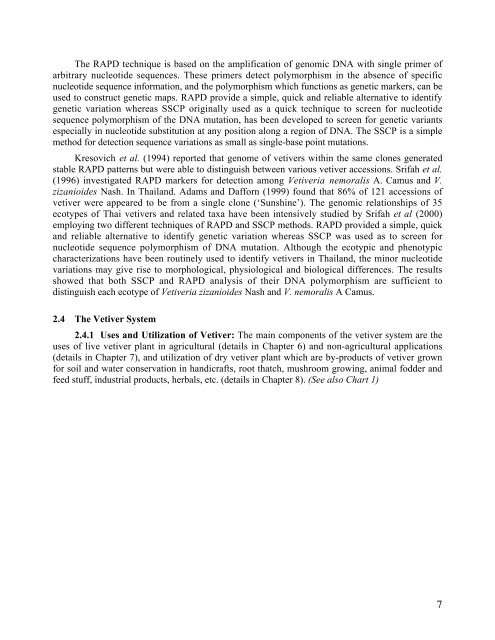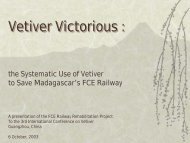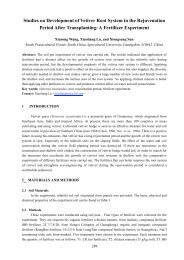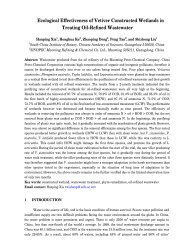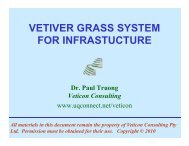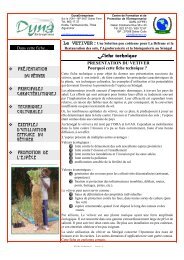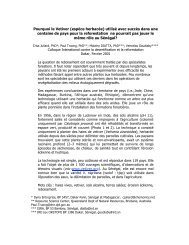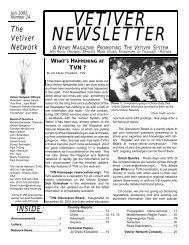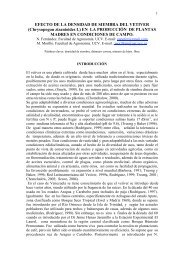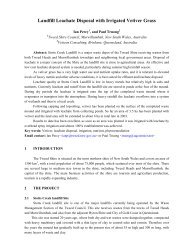Training manual - The Vetiver Network International
Training manual - The Vetiver Network International
Training manual - The Vetiver Network International
You also want an ePaper? Increase the reach of your titles
YUMPU automatically turns print PDFs into web optimized ePapers that Google loves.
<strong>The</strong> RAPD technique is based on the amplification of genomic DNA with single primer of<br />
arbitrary nucleotide sequences. <strong>The</strong>se primers detect polymorphism in the absence of specific<br />
nucleotide sequence information, and the polymorphism which functions as genetic markers, can be<br />
used to construct genetic maps. RAPD provide a simple, quick and reliable alternative to identify<br />
genetic variation whereas SSCP originally used as a quick technique to screen for nucleotide<br />
sequence polymorphism of the DNA mutation, has been developed to screen for genetic variants<br />
especially in nucleotide substitution at any position along a region of DNA. <strong>The</strong> SSCP is a simple<br />
method for detection sequence variations as small as single-base point mutations.<br />
Kresovich et al. (1994) reported that genome of vetivers within the same clones generated<br />
stable RAPD patterns but were able to distinguish between various vetiver accessions. Srifah et al.<br />
(1996) investigated RAPD markers for detection among <strong>Vetiver</strong>ia nemoralis A. Camus and V.<br />
zizanioides Nash. In Thailand. Adams and Dafforn (1999) found that 86% of 121 accessions of<br />
vetiver were appeared to be from a single clone (‘Sunshine’). <strong>The</strong> genomic relationships of 35<br />
ecotypes of Thai vetivers and related taxa have been intensively studied by Srifah et al (2000)<br />
employing two different techniques of RAPD and SSCP methods. RAPD provided a simple, quick<br />
and reliable alternative to identify genetic variation whereas SSCP was used as to screen for<br />
nucleotide sequence polymorphism of DNA mutation. Although the ecotypic and phenotypic<br />
characterizations have been routinely used to identify vetivers in Thailand, the minor nucleotide<br />
variations may give rise to morphological, physiological and biological differences. <strong>The</strong> results<br />
showed that both SSCP and RAPD analysis of their DNA polymorphism are sufficient to<br />
distinguish each ecotype of <strong>Vetiver</strong>ia zizanioides Nash and V. nemoralis A Camus.<br />
2.4 <strong>The</strong> <strong>Vetiver</strong> System<br />
2.4.1 Uses and Utilization of <strong>Vetiver</strong>: <strong>The</strong> main components of the vetiver system are the<br />
uses of live vetiver plant in agricultural (details in Chapter 6) and non-agricultural applications<br />
(details in Chapter 7), and utilization of dry vetiver plant which are by-products of vetiver grown<br />
for soil and water conservation in handicrafts, root thatch, mushroom growing, animal fodder and<br />
feed stuff, industrial products, herbals, etc. (details in Chapter 8). (See also Chart 1)<br />
7


